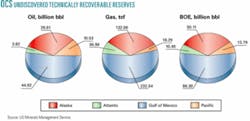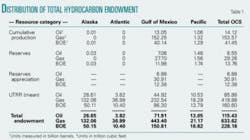A report early this month by the US Minerals Management Service shows big oil and gas potential in areas of the Outer Continental Shelf now off-limits to drilling.
The MMS report to Congress estimated the undiscovered, technically recoverable resource (UTRR) in all federal offshore areas at mean values of 85.9 billion bbl of oil and at 419.9 tcf of gas. More than half of the oil-equivalent UTRR is in the Gulf of Mexico.
Data for the 2006 assessment, required by Sect. 357 of the Energy Policy Act of 2005, were collected and compiled by Offshore Minerals Management program personnel. The assessment represents a comprehensive appraisal that considered information available as of Jan. 1, 2003, and incorporated improved assessment methodologies. No new government-sponsored geological or geophysical data acquisition was undertaken for this inventory.
Assessment findings
The total endowment of technically recoverable oil and gas on the OCS-the portion of the submerged seabed whose mineral estate is subject to federal jurisdiction-comprises known resources plus estimates of undiscovered resources.
“Technically recoverable” estimates represent the amount of oil or gas that could be produced with existing-or reasonably foreseeable-technology, the report said. Current technologies include drilling in water deeper than 10,000 ft and subsea depths in excess of 31,000 ft.
Also, the report noted, “Technically recoverable resources are hydrocarbons potentially amenable to conventional production regardless of the size, accessibility, and economics of the accumulations assessed.”
The OCS’s total hydrocarbon endowment-all conventionally recoverable hydrocarbon resources of an area, or the sum total of UTRR, cumulative production, proved reserves, unproved reserves, and reserves appreciation-is 115.4 billion bbl of oil and 633.7 tcf of gas. “Reserves appreciation” is defined as the projected increase in current estimates of reserves in existing fields based on historical trends. On an oil-equivalent basis, about two thirds of the total endowment is projected for the gulf region.
Of the total endowment, about 29.6 billion bbl of oil and 213.8 tcf of gas are represented by resources in known fields. Cumulative production on the OCS through 2002 was 14.1 billion bbl of oil and 153.6 tcf of gas, about 97% of which was produced in the gulf. Historical production represents 18% of the estimated mean total endowment.
Estimates of the discovered resources remaining to be produced-reserves and reserves appreciation-are 15.4 billion bbl of oil and 60.2 tcf of gas. MMS estimates that reserves remaining within the 1,151 fields discovered as of Jan. 1, 2003, total 8.6 billion bbl of oil and 29.3 tcf of gas.
An additional volume of reserves appreciation totaling 6.9 billion bbl of oil and 30.9 tcf of gas also is forecast to be ultimately recoverable from this same set of existing offshore fields. “This growth occurs primarily from the discovery of new reservoirs and an increase in the estimate of the recoverable portion of in-place hydrocarbons within known reservoirs, due to future advances in technology, an increased understanding of reservoir performance, and improvements in economics,” the report said.
During the period between the most recent assessment and that compiled in 2001, about 2.3 billion bbl of oil and nearly 20 tcf of gas were produced from the OCS, 96% from the gulf, the report said.
“Despite this significant volume of oil production, the estimate of oil reserves (including reserves appreciation) grew during this period, increasing by about 1.7 billion bbl of oil, meaning the industry was successful in replacing all the oil reserves produced in the gulf,” the report noted. “This is not the case for natural gas. The estimate for gas reserves (including appreciation) decreased by 45 tcf, yet production during this time period totaled 20 tcf, meaning that discoveries of new sources of OCS gas are currently not keeping pace with our consumption of them.”
The report said, therefore, that if US demand for gas continues at current levels or increases, new domestic sources will have to be discovered or imports of gas or LNG will need to increase.
Interpretation
“The results of this assessment indicate that the OCS remains a significant potential domestic source of new natural gas resources from fields yet to be discovered,” the report said. The MMS estimate for gas UTRR on the OCS has risen by 16%, and the oil UTRR rose 15% from 2001 assessments.
“If these volumes of oil and gas are in fact discovered, any resulting new reserves could help offset the declining gas reserve volumes on the OCS and provide new sources of domestic production,” the assessment said.
The rise in the UTRR volumes estimates, the report noted, is mainly attributable to the gulf, where the UTRR increased by 12.8 billion bbl of oil and more than 40 tcf of gas. “Not surprisingly,” the report said, “the increase in the oil estimate was predominately within deepwater gulf plays (water depths greater than 800 m).” The rise in gas estimates primarily is associated with deep or ultradeep plays in shallow waters on the gulf shelf.
The report stressed that resource assessment techniques have become more sophisticated over recent years. “Today the oil and gas industry possesses the ability to drill exploratory wells in water depths exceeding 10,000 ft and to exploit discoveries in over 7,500 ft. The use of 3D and other advanced seismic data and interpretation techniques has served as a catalyst to transform the geosciences and the petroleum industry,” the report said.
With the phenomenal changes that have occurred over the past 3 decades, the report stated, “it is impossible to determine to what degree changes in the assessments are attributable to specific changes in [geological and geophysical] information or a particular individual technological advance.”
Disappointments, impediments
The report cited “major disappointments” on the Alaska OCS, particularly in portions of the Bering Sea and off southern Alaska and along the Atlantic continental shelf.
“However, it has been 20 years or more since any exploration activity occurred in these areas,” it said. “In other areas, such as central and northern California, offshore Oregon and Washington, and the south Florida basin, there has been no meaningful exploration activity since the 1960s.”
The resource potential of areas in the central, western, and parts of the eastern gulf are “experiencing robust levels of exploration and production effort,” the report noted.
Certain frontier areas-such as parts of the eastern gulf and other offshore areas under longstanding congressional moratoriums-“offer potential larger field-size discoveries,” the report said. But drilling and seismic surveys have been rare in these areas so conservative estimates of potential resources have been made, MMS said.
“Many in the industry believe that the resource potential may be larger than reflected by present evaluations, and the more an area is successfully explored, the more its resource estimates tend to grow,” the report said.
Impediments remain for industry’s development of certain areas of the OCS, including lack of access to large portions of the OCS, as well as legal and regulatory requirements and policies designed to ensure safety and environmental protection.
MMS estimates the UTRR in OCS areas currently off-limits to leasing and development at 18.92 billion bbl of oil and 85.79 tcf of gas (mean estimates). By OCS area, the inaccessible UTRR breaks out like this: North Aleutian Basin 750 million bbl and 8.62 tcf; Washington-Oregon 400 million bbl and 2.28 tcf; Northern California 2.08 billion bbl and 3.58 tcf; Central California 2.31 billion bbl and 2.41 tcf; Southern California 5.58 billion bbl and 9.75 tcf; Eastern Gulf of Mexico 3.98 billion bbl and 22.16 tcf; and North, Mid, and South Atlantic 3.82 billion bbl and 36.99 tcf.
“The ongoing legislative and executive withdrawals mean that large portions of the OCS, covering about 611 million acres, are off-limits to oil and gas leasing, exploration, and development,” the report said. “Although the MMS has already taken a number of actions to promote resource development...it continues to investigate ways to promote environmentally acceptable development and avoid unnecessary delays for OCS program activities.” ✦



